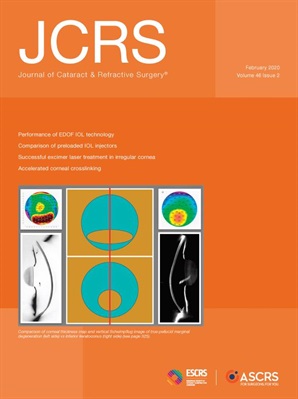JCRS Highlights from Professor Thomas Kohnen, European Editor, JCRS

Thomas Kohnen
Published: Friday, April 3, 2020
 EDOF Evolution
Several extended depth-of-focus (EDOF) IOLs are being developed to bridge the current clinical shortcomings between monofocal and multifocal IOLs. The primary objectives are to provide improved visual acuity at intermediate distances with fewer or less severe visual disturbances and better contrast sensitivity. A review article describes the four main types of EDOF IOL and provides information on the clinical experiences with the technology. The four EDOF technologies now in the clinic include: small-aperture design IOLs; bioanalogic IOLs; diffractive optics; and non-diffractive optical manipulations. The article notes that in general EDOF IOLs provide good-to-excellent visual acuity at distance, improved intermediate visual acuity compared with monofocal IOLs and functional near visual acuity. T Kohnen et al., Extended depth-of-focus technology in intraocular lenses, Volume 46, #2, pp 298-304
Waste Not
The healthcare sector is one of the largest contributors to greenhouse gas emissions. And with cataract surgery accounting for a large percentage of surgeries performed worldwide, efforts are under way to reduce its associated waste. Malaysian researchers conducted a prospective study of waste associated with 203 phacoemulsification cataract procedures. The total waste produced was 167.965 kg, of which 56.6% was clinical waste, 37.6% was general waste and 5.8% was sharps. A little over half of the general waste was recyclable. Trainees produced significantly more waste than experienced surgeons. The researchers suggest that increasing the efficiency of resource use and extending the useful life of products would help reduce waste production, while immediate sequential bilateral cataract surgery could improve efficiency. HG Khor et al., “Waste production from phacoemulsification surgery”, Volume 46, #2, pp 215-221.
Dropped nucleus
An analysis from the European Registry of Quality Outcomes for Cataract and Refractive Surgery (EUREQUO) suggests good news and bad news on the issue of dropped nucleus. The analysis of 1,715,348 cases revealed a rate of dropped nucleus of 0.071%.White cataract, previous vitrectomy, poor preoperative visual acuity, small pupil, pseudoexfoliation, diabetic retinopathy and male sex were significantly related to dropped nucleus. The bad news – eyes with the complication of a dropped nucleus also had a poorer visual and refractive outcome compared with eyes with existing risk factors but no such complication. The good news – the overall rate of dropped nucleus showed a significant trend of decreasing occurrence over time. M Lundström et al., “Risk factors for dropped nucleus in cataract surgery as reflected by the European Registry of Quality Outcomes for Cataract and Refractive Surgery”, Volume 46, #2, pp 287-292.
EDOF Evolution
Several extended depth-of-focus (EDOF) IOLs are being developed to bridge the current clinical shortcomings between monofocal and multifocal IOLs. The primary objectives are to provide improved visual acuity at intermediate distances with fewer or less severe visual disturbances and better contrast sensitivity. A review article describes the four main types of EDOF IOL and provides information on the clinical experiences with the technology. The four EDOF technologies now in the clinic include: small-aperture design IOLs; bioanalogic IOLs; diffractive optics; and non-diffractive optical manipulations. The article notes that in general EDOF IOLs provide good-to-excellent visual acuity at distance, improved intermediate visual acuity compared with monofocal IOLs and functional near visual acuity. T Kohnen et al., Extended depth-of-focus technology in intraocular lenses, Volume 46, #2, pp 298-304
Waste Not
The healthcare sector is one of the largest contributors to greenhouse gas emissions. And with cataract surgery accounting for a large percentage of surgeries performed worldwide, efforts are under way to reduce its associated waste. Malaysian researchers conducted a prospective study of waste associated with 203 phacoemulsification cataract procedures. The total waste produced was 167.965 kg, of which 56.6% was clinical waste, 37.6% was general waste and 5.8% was sharps. A little over half of the general waste was recyclable. Trainees produced significantly more waste than experienced surgeons. The researchers suggest that increasing the efficiency of resource use and extending the useful life of products would help reduce waste production, while immediate sequential bilateral cataract surgery could improve efficiency. HG Khor et al., “Waste production from phacoemulsification surgery”, Volume 46, #2, pp 215-221.
Dropped nucleus
An analysis from the European Registry of Quality Outcomes for Cataract and Refractive Surgery (EUREQUO) suggests good news and bad news on the issue of dropped nucleus. The analysis of 1,715,348 cases revealed a rate of dropped nucleus of 0.071%.White cataract, previous vitrectomy, poor preoperative visual acuity, small pupil, pseudoexfoliation, diabetic retinopathy and male sex were significantly related to dropped nucleus. The bad news – eyes with the complication of a dropped nucleus also had a poorer visual and refractive outcome compared with eyes with existing risk factors but no such complication. The good news – the overall rate of dropped nucleus showed a significant trend of decreasing occurrence over time. M Lundström et al., “Risk factors for dropped nucleus in cataract surgery as reflected by the European Registry of Quality Outcomes for Cataract and Refractive Surgery”, Volume 46, #2, pp 287-292.